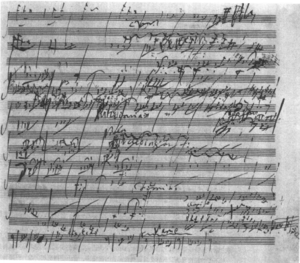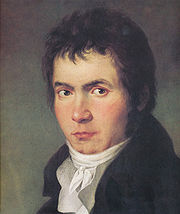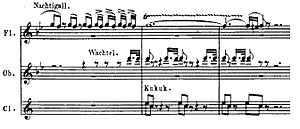
Symphony No. 6 (Beethoven)
Did you know...
Arranging a Wikipedia selection for schools in the developing world without internet was an initiative by SOS Children. Click here to find out about child sponsorship.
Symphony No. 6 in F major, Op. 68, also known as the Pastoral Symphony (German Pastoral-Sinfonie), is a symphony composed by Ludwig van Beethoven, and was completed in 1808. One of Beethoven's few works containing explicitly programmatic content, the symphony was first performed in the Theatre an der Wien on 22 December 1808 in a four hour concert.
The work has become one of the central works of the symphonic repertoire. It is frequently performed, and has been often recorded.
Background
Beethoven was a lover of nature who spent a great deal of his time on walks in the country. He frequently left Vienna to work in rural locales.
The first sketches of the Pastoral Symphony appeared in 1802. It was composed simultaneously with Beethoven's more famous—and more fiery— Fifth Symphony. Both symphonies were premiered in a long and under-rehearsed concert in the Theatre an der Wien in Vienna, on 22 December 1808.
The composer said that the Sixth Symphony is "more the expression of feeling than painting", a point underlined by the title of the first movement ("Awakening of cheerful feelings...").
Instrumentation
The symphony is scored for piccolo (fourth movement only), 2 flutes, 2 oboes, 2 clarinets in B flat, 2 bassoons, 2 horns in F and B flat, 2 trumpets in C and E flat (third, fourth, and fifth movements only), 2 trombones (alto and tenor, fourth and fifth movements only), timpani (fourth movement only), and strings.
Form
The symphony has five movements, rather than the four typical of symphonies of the Classical era. Beethoven annotated the beginning of each movement as follows:
- Erwachen heiterer Empfindungen bei der Ankunft auf dem Lande (Awakening of cheerful feelings upon arrival in the country): Allegro ma non troppo
- Szene am Bach (Scene at the brook): Andante molto mosso
- Lustiges Zusammensein der Landleute (Happy gathering of country folk): Allegro
- Gewitter, Sturm (Thunderstorm; Storm): Allegro
- Hirtengesang. Frohe und dankbare Gefühle nach dem Sturm (Shepherds' song; cheerful and thankful feelings after the storm): Allegretto
The third movement ends on an imperfect cadence that leads straight into the fourth; the fourth movement leads straight into the fifth without a pause. A performance of the work lasts about 40 minutes.
Description of movements
I. Allegro ma non troppo
The symphony begins with a placid and cheerful movement depicting the composer's feelings as he arrives in the country. The work is in sonata form, and its motifs are extensively developed. At several points Beethoven builds up orchestral texture by multiple repetitions of very short motifs. Yvonne Frindle commented, "the infinite repetition of pattern in nature [is] conveyed through rhythmic cells, its immensity through sustained pure harmonies."
II. Andante molto mosso
This movement, titled by Beethoven "By the brook," is in 12/8 meter; the key is B flat major, the subdominant of the main key of the work. The movement is in sonata form.
At the opening the strings play a motif that clearly imitates flowing water. The cello section is divided, with just two players playing the flowing-water notes on muted instruments, with the remaining cellos playing mostly pizzicato notes together with the double basses.
Toward the end of the movement, in the coda that begins at measure 124, there is a cadenza for three woodwind instruments that imitates bird calls. Beethoven helpfully identified the bird species in the score: nightingale (flute), quail (oboe), and cuckoo (clarinet).
III. Allegro
This is a scherzo, which depicts country folk dancing and reveling. It is in F major, returning to the main key of the symphony.
The form of the movement is an altered version of the usual form for scherzi, in that the trio appears twice rather than just once, and the third appearance of the scherzo theme is truncated. Perhaps to accommodate this rather spacious arrangement, Beethoven did not mark the usual internal repeats of the scherzo and the trio. Theodor Adorno identifies this scherzo as the model for the scherzos by Anton Bruckner.
The final return of the theme conveys a riotous atmosphere with a faster tempo. The movement ends abruptly, leading without a pause into the fourth movement.
IV. Allegro
The fourth movement, in F minor, depicts a violent thunderstorm with painstaking realism, building from just a few drops of rain to a great climax with thunder, lightning, high winds, and sheets of rain. The storm eventually passes, with an occasional peal of thunder still heard in the distance. There is a seamless transition into the final movement. This movement parallels Mozart's procedure in his String Quintet in G minor K. 516 of (1787), which likewise prefaces a serene final movement with a long, emotionally stormy introduction.
V. Allegretto
The finale is in F major and is in 6/8 time. The movement is written in sonata rondo form, meaning that the main theme appears in the tonic key at the beginning of the development as well as the exposition and the recapitulation. Like many classical finales, this movement emphasizes a symmetrical eight-bar theme, in this case representing the shepherds' song of thanksgiving. The mood throughout is unmistakably joyful.
The coda, which Antony Hopkins has called "arguably the finest music of the whole symphony," starts quietly and gradually builds to an ecstatic culmination for the full orchestra (minus "storm instruments"), with the first violins playing very rapid triplet tremolo on a high f. There follows a fervent passage suggestive of prayer, marked by Beethoven "pianissimo, sotto voce"; most conductors slow the tempo for this passage. After a brief period of afterglow, the work ends with two emphatic F major chords.
 |
First movement: allegro non troppo
Performed by the Skidmore College Orchestra. Music courtesy of Musopen
|
| Problems listening to this file? See media help. | |
 |
Second movement: andante molto mosso
Performed by the Skidmore College Orchestra. Music courtesy of Musopen
|
| Problems listening to this file? See media help. | |
 |
Third movement: allegro
Performed by the Skidmore College Orchestra. Music courtesy of Musopen
|
| Problems listening to this file? See media help. | |
 |
Fourth movement: allegro
Performed by the Skidmore College Orchestra. Music courtesy of Musopen
|
| Problems listening to this file? See media help. | |
 |
Fifth movement: allegretto
Performed by the Skidmore College Orchestra. Music courtesy of Musopen
|
| Problems listening to this file? See media help. | |



